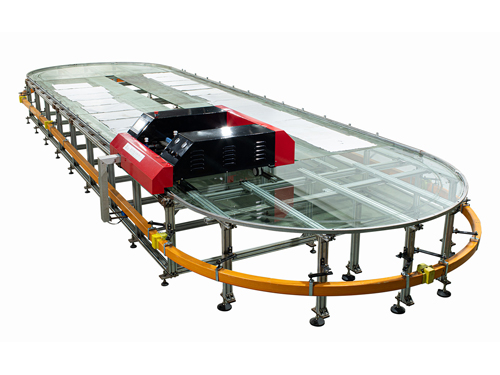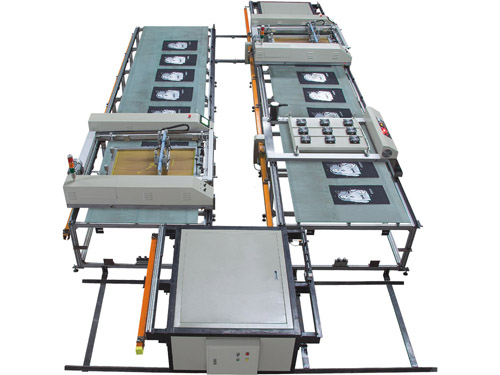Printing dry goods | 2 minutes to quickly understand "flatbed screen printing machine"
If you are interested in topics such as "structure of flatbed screen printing machine", "working principle", "what are the requirements of screen printing machine for screen printing", and "advantages" and want to know more, please follow the editor to take a look!
1. Definition of flatbed screen printing machine
A flatbed screen printing machine is a method of printing on a flat substrate with a flat-screen printing plate. During printing, the printing plate is fixed and the ink knife moves. Graphic printing includes paper printing, long table printing, and cylinder printing. Graphic printing mainly targets single-sheet prints such as advertisements, cards, and metal and plastic signs.
Flat printing can be divided into:
①Manual printing with the squeegee in hand
②The scraping of the squeegee is driven by mechanical transmission, and the feeding and taking out of the substrate is semi-automatic printing by hand.
③ The squeegee printing and the movement of the substrate are all automatic printing and screen printing machines with mechanical transmission.
2. Structure of flatbed screen printing machine
How does flatbed screen printing machine printing work? To understand the working principle of a flatbed screen printing machine, we must first know its structure. Flatbed Screen Printing Machine consists of a transmission device, a printing plate device, a printing device, a supporting device (ie a printing platform), a plate registration mechanism, a drying device, and electrical control. device and other components.
3. Principle of flatbed screen printing machine
When working, the power is transmitted through the transmission mechanism, so that the squeegee presses the ink and the screen printing plate in motion, so that the screen printing plate and the substrate form a pressing line. The ink plate generates force F2, and the rebound force makes the screen printing plate, not in contact with the substrate except the embossing line. Missed printing on the substrate.
During the printing process, the screen printing plate and the squeegee move relative to each other, and the extrusion force F1 and the rebound force F2 also move synchronously. Dirty blots. That is, the screen is constantly deformed and rebounded during the printing stroke.
The squeegee is separated from the substrate together with the screen printing plate after the one-way printing is completed, and at the same time, the ink is returned to the back, that is, a printing cycle is completed.
4. What are the requirements of the screen printing machine for the screen?
The flat-screen printing machine uses a flat-screen plate for printing. In addition to selecting different textures of a screen according to different printing requirements, there are some basic requirements for the screen itself. The requirements of the flat screen printing machine for the screen mainly include: :
①The wire mesh should have qualified strength to meet the tension requirements during stretching and printing.
② The mesh size of the screen should be uniform to ensure a uniform amount of ink leakage.
③ Strong solvent resistance, the physical properties of the wire mesh should remain unchanged after contacting the solvent.
④ The surface of the screen wire should be smoother to reduce the phenomenon of blocking the mesh during the printing process.
⑤Since the screen is in contact with water in the process of printing and plate making, it is required that the shrinkage and elongation of the screen should be small after it encounters water.
⑥ The abrasion resistance should be high, and the screen should have qualified abrasion resistance to ensure that the screen printing plate has a high printing resistance (the screen with high abrasion resistance can also be recycled and reused).
5. Advantages of flat screen printing
① Screen printing can use various types of ink. Namely: oily, water-based, synthetic resin emulsion type, powder, and other types of ink.
②The layout is soft. The screen printing layout is soft and has a certain elasticity, not only suitable for printing on soft items such as paper and cloth but also printing on hard items, such as glass, ceramics, etc.
③ Screen printing has low embossing force. It is also suitable for printing on fragile objects due to the low pressure used during printing.
④The ink layer is thick and the covering power is strong.
⑤ It is not limited by the surface shape of the substrate and the size of the area. As can be seen from the foregoing, screen printing can be printed not only on flat surfaces, but also on curved or spherical surfaces; it is not only suitable for printing on small objects, but also printing on very large objects. This printing method has great flexibility and wide applicability.
6. What is the difference between "flexographic printing", "screen printing", "lithographic printing" and "gravure printing"?
Flexography, also often referred to as flexographic printing, is a printing method that uses a flexographic plate and transfers ink through an anilox roller. For flexographic printing, the printing plate generally uses a photosensitive resin plate with a thickness of 1-5mm. Ink is divided into three categories, namely water-based ink, alcohol-soluble ink, and UV ink. Since the ink used in flexographic printing is in line with green environmental protection, it has been widely used in food packaging printing and has broad prospects. Flexo printing is a type of letterpress printing.
Screen printing belongs to stencil printing, and it is called the four major printing methods together with lithographic printing, letterpress printing, and gravure printing. Stencil printing includes transcription, perforated pattern, spray pattern, and screen printing. The principle of stencil printing is: during printing, the printing plate (paper film plate or another plate base with holes through which the ink can pass through) transfers the ink through the holes of the stencil to the substrate (paper, ceramics, etc.) through a certain pressure. ) to form images or text.
Since the graphic part and the non-graphic part on the lithographic printing plate are almost on the same plane, during printing, to make the ink distinguish between the graphic part and the non-graphic part of the printing plate, the water supply of the printing plate parts is first The device supplies water to the non-graphic part of the printing plate, thereby protecting the non-graphic part of the printing plate from wetting by ink. Then, ink is supplied to the printing plate by the ink supply device of the printing part. Since the non-graphic part of the printing, the plate is protected by water, the ink can only be supplied to the graphic part of the printing plate. Finally, the ink on the printing plate is transferred to the blanket, and then the pressure between the blanket cylinder and the impression cylinder is used to transfer the ink on the blanket to the substrate to complete one printing. Therefore, lithography is a kind of indirect printing.
Gravure printing is a plate-making technique in which images are engraved indentations from a surface. Generally speaking, a copper or zinc plate is used as the engraved surface, and the concave part can be printed by etching, engraving, copper engraving, or lithography, possibly according to gravure printing. To print a gravure plate, the surface is covered with ink, then a tartan cloth or newspaper is used to wipe the ink from the surface, leaving only the concave portion. The wet paper is placed on the upper part of the printing plate, and the printing plate and paper are pressed by the printing press to transfer the ink from the recessed part of the printing plate to the paper.
Flatbed Screen Printing Machine recommendation
SPU Series Mini flatbed printing machine can update your manual print table into automatic print table,and realize the modernization of printing.you only need to buy SPU printer and semi-circular rack for both end of the table.No need to modify your old table or buy new table.It won't damage your factory’s layout. Low investment and fast return.It is suitable for printing shoe material,slippers, leather, garment sheet, luggage&bag fabric, Rubbers,PVC sheet ,glass and planiform gift etc. And it’s Suitable for various printing past,water-based ink, slovent ink and pigment etc.
SPT series automatic flatbed screen printer is the innovative high-tech automatic flatbed printing equipments.The machine upgrades the traditional manual flatbed printer with intelligent micro-processor and vivid touch screen display,it provides high-precision colors registration,stability machine moving,lowering the labor costs but upgrade print quality and increasing the production.The unit machine’s light-weight is for easy operation.
Summary:
Since Changs Machinery's establishment in 2004, Wingspan has been focusing on technology investment and product quality, providing automatic computer UV screen printing machines, automatic textile screen printing machines, semi-automatic textile printing machines, automatic flatbed printing machines, manual printing machines, and cylinder printing machines. , balloon printing machine and printing accessories, etc., suitable for high-color-to-color registration printing of clothing and leather, and also suitable for printing stationery, handbags, gift boxes, such as cigarette boxes, decorative boxes, metal sheets, soft and hard plastic plates, cloth board, glass board, ceramic, and other colors.
 English
English 中文
中文





